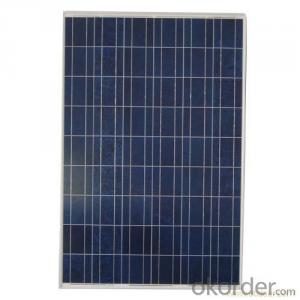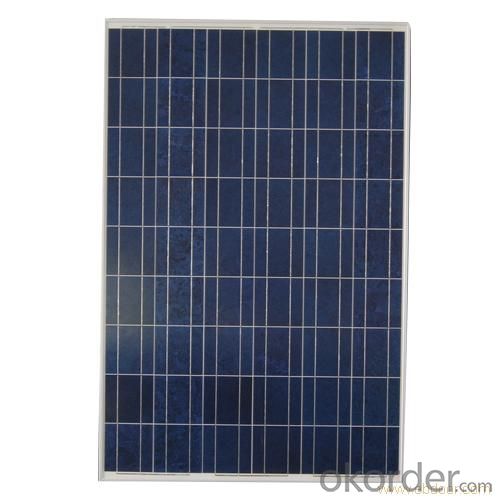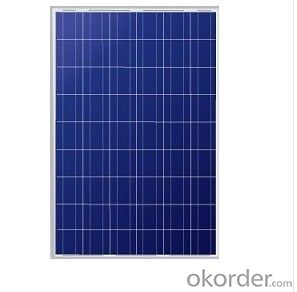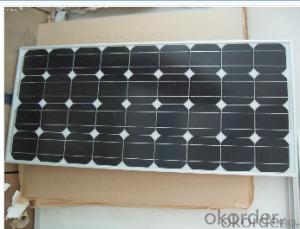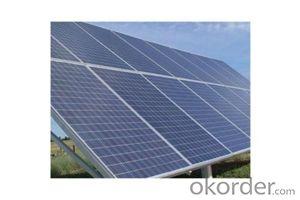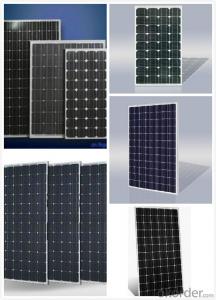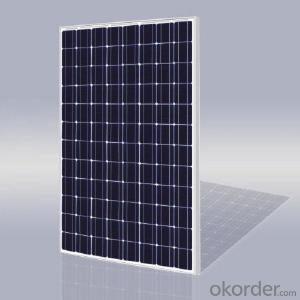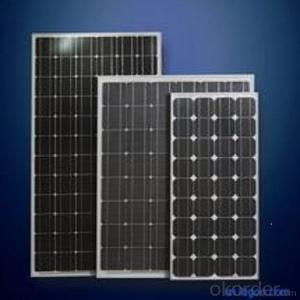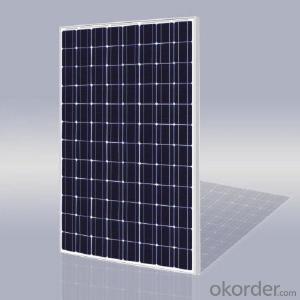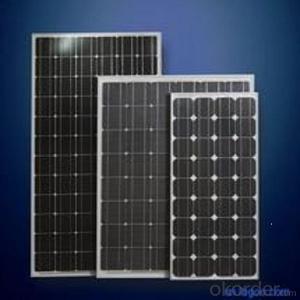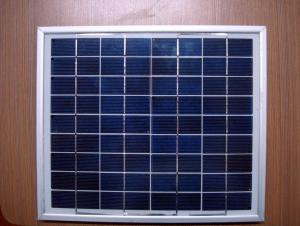Nice Solar Panels - Low Price, High Quality Solar Modules
- Loading Port:
- Shanghai
- Payment Terms:
- TT OR LC
- Min Order Qty:
- 2500 watt
- Supply Capability:
- 25000 watt/month
OKorder Service Pledge
OKorder Financial Service
You Might Also Like
Specification
We now provide
• Monocrystalline Solar Panel
• Polycrystalline Solar Panel
Features of our products:
• High conversion efficiency mono/poly-crystalline amorphous silicon solar cells
• Modules incorporate high performance bypass diodes to minimize the power drop caused by shading
• High transmittance, low-iron tempered glass
• High performance EVA encapsulant to prevent destroying and water.
• AI frame: without screw, corner connection. 8 holes on the frame can be installed easily
• Good performance of preventing from atrocious weather such as wind and hails
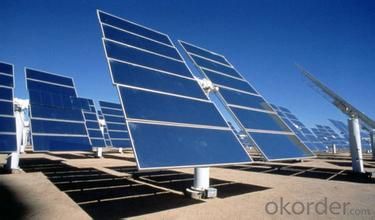
Polycrystalline Silicon Solar Modules 48Cell-195W Specification
ELECTRICAL PERFORMANCE | |||
Power output | P max | W | 195 |
Power output tolerances | ΔP max | W | 0/+5 |
Module effi ciency | η m | % | 14.7 |
Voltage at Pmax | V mpp | V | 23.7 |
Current at Pmax | I mpp | A | 8.03 |
Open-circuit voltage | V oc | V | 30.1 |
Short-circuit current | I sc | A | 8.65 |
Product Description:
This installation Manual contains essential information for the electrical and mechanical installation that your must know before installing CUSTOMER PV modules. This also contains safety information you need to be familiar with .All the information described in this manual are the intellectual property of CNBM and based on the technologies and experiences that have been acquired and accumulated in the long history of CUSTOMER. This document does not constitute a warranty, expressed or implied.
CUSTOMER does not assume responsibility and expressly disclaims liability for loss, damage, or expense arising out of in anyway connected with installation, operation, use or maintenance of the PV modules. No responsibility is assumed by CUSTOMER for any infringement of patents or other rights of third parties that may result from use of PV module.
CUSTOMER reserves the right to make changes to the product, specifications or installation manual without prior notice.
Solar panel working process
In addition to being the ultimate source of all life on earth, the sun is an infinitely renewable, completely pollution-free source of electricity. Instead of burning fossil fuels dug up from the ground in a big power plant – a very 19th century, industrial age approach, when you think about it – solar panels convert sunlight directly into electricity, with no harmful emissions.
The basic unit of a solar panel is a solar cell, which usually consists of one or two layers of silicon-based semiconductor wafers. When struck by the photons in sunlight, the solar cell generates an electrical charge due to the "photovoltaic effect" – which is a pretty good name, since it produces voltage from photons. The flow of these electrons moves in a steady electrical current from one side of the cell to the other.
Dozens of these PV cells are packaged together into solar modules, which in turn are packaged into solar panels that are mounted on a rooftop and arranged to maximize their hours of exposure to direct sunlight. Because the electricity generated by all those solar cells is direct current (DC), it is then sent to an inverter that transforms the power into the same alternating current (AC) used by the appliances in your home and the local utility electricity distribution grid. Increasingly, these inverters are getting "smart," providing data monitoring for solar installation performance and other grid integration services.
Features
1.High conversion efficiencies resulting in superior power output performance.
2.Outstanding power output even in low light or high temperature conditions
3.Optimized design for ease of soldering and lamination
4.Long-term stability,reliability and performance
- Q: I had an idea for new parabolic solar panels shaped like horseshoes. They can install them outside buildings facing the equator. They could angle them from the ground based on how many degrees latitude the location and rotate them according to seasonal changes. The disadvantage of photovoltaic panels is that they are not all capable of receiving direct sunlight. That is the quintessential reason I believe horseshoe solar panels are more effective than flat rectangular ones. One side could function in the morning; the middle could perform at midday; and the other could operate during the evening. That method seems more sensible than hourly positioning. I'm certain horseshoe panels could save and produce more electricity. A football stadium, shopping mall, or outlet center would be a fantastic place. What do you think?
- Sorry to be a prophet of doom again but the fault in the system is that only a small portion of the cell is used at any time of the day, given the high cost of solar panels this is not financially viable. Why not just have a small motor to turn the panel to face the sun, that's been done and it works.
- Q: I'm trying to charge rechargeable AA batteries with a solar panel. What guage wire should I use to connect the panel to the batteries? Should I use a diode to keep the batteries from overpowering the circuit? If so, what size? My panel is 4.8V 50mA.
- How photograph voltaic Cells artwork via Scott Aldous interior this text a million. advent to How photograph voltaic Cells artwork 2. Photovoltaic Cells: changing Photons to Electrons 3. How Silicon Makes a photo voltaic cellular 4. Anatomy of a photo voltaic cellular 5. power Loss in a photo voltaic cellular 6. photograph voltaic-powering a house 7. fixing photograph voltaic-power subjects 8. photograph voltaic-power experts and Cons 9. so a lot greater coaching 0. See all actual technological understanding articles you have probably seen calculators that have photograph voltaic cells -- calculators that for the period of no way decide for batteries, and specially circumstances do no longer even have an off button. as long as you have sufficient easy, they seem to artwork invariably. you need to have seen larger photograph voltaic panels -- on emergency highway signs and warning signs or call bins, on buoys, even in parking a lot to power lighting fixtures furniture. in spite of the undeniable fact that those larger panels are not as common as photograph voltaic powered calculators, they're accessible, and not that troublesome to locate in case you comprehend the place to look. There are photograph voltaic cellular arrays on satellites, the place they're used to power the electrical powered structures. you have probably additionally been listening to with reference to the photograph voltaic revolution for the final 2 many years -- the theory sooner or later we can all use loose electrical energy from the sunlight. this could nicely be a seductive promise: On a marvelous, sunny day, the sunlight shines approximately a million,000 watts of power in line with sq. meter of the planet's floor, and if we ought to deliver jointly all of that power we ought to actual power our homes and places of work for loose.
- Q: how fast does a 25watt solar panel generate power to a battery? trying to figure out a conversion factor here to get a rough estimate of how many i would need to power my house, please help?
- To figure our how many you need, take a look at your power bill. It will tell you how many kilowatt/hours you used during the month. My bill says I use about 2000 kilowatt/hours per month, or about 2000 kwh /30 days=67 kw/h hours per day. That is 67,000 watt hours. To supply that with solar panels, you have to generate at least 67,000 watt hours, but you don't have a full day to do it, since you have to do it while the sun is up. So you put the energy into batteries during the day, so you can use it at night. A 25 watt panel generates about 25 watts when fully illuminated by the sun. If you fully illuminate it for an hour, you get 25 watt hours. If you get 2 hours of sunlight a day, that would seem to imply that I need 67000 watt hours/25 watts /2 hours=45 panels. But for most of the day, the sun isn't hitting the panel fully, so it isn't going to generate the full 25 watts. When the sun is 45 degrees to the side, you only get about 70%. When the sun is 60 deg to the side, you only get 50%. And what do you do on cloudy days? And the shorter days in the winter? To make up for this, you have to increase the number of panels to make up for the loss. So in reality, I might need double this number of panels, for realiable solar power throughout the year. That works out to about 90 panels, or ,250 watts worth for my house.
- Q: I contend:As far as the solar panels causing global warming I'll try to explain. If you put a black panel on the ground or on your house and don't connect it to anything, it will absorb solar energy (heat) during daylight and release it at night (radiation). The net heat gain is zero. If you hook up a solar panel in the same place but hook it up to batteries, charge the batteries during sunlight hours and using that energy to electrically heat the home at night. The panels will absorb solar energy during the day but will convert that to electrical energy in the batteries instead of radiating it back into space at night. The result is a net gain in earth's temperature.Right or wrong?
- One piece of technology: Hydro-energy storage. Pump water up to an artificial lake at the top of a mountain to store energy, and then let the water run down through turbines to retrieve the energy later, eliminating most or all of the need for batteries. Usually this stuff saying renewables suck is BS when you actually try. Yet another method, are solar power towers which last longer than solar panels and continue to generate energy at night. While a non-universal storage method, it's good for storing the sun's energy in the mechanism that generates the power. According to some studies, they are the best option next to wind turbines. I'll describe a particular model. A field of mirrors beams light to a part of the tower which contains salt, for it's incredible heat storage capacity when molten. In turn, the heat from that region heats water which spins some turbines, generating lots of energy. Currently, the best models continue to generate electricity at night and for a few consecutive cloudy days. I think whoever was saying that was probably trying to delay response. There are too many ways around that to be true, and saying that it contributes more to Global Warming than fossil fuels is a lie. This is why some government intervention is needed: The companies aren't responding to new ideas, and they happen to often be fossil fuel companies as well. If you don't create the environment where it lowers fossil fuel consumption, then they win because prices stay high.
- Q: I have a solar panel, charge regulator, inverter....is that all I need to tie it into my grid? Do I just plug the solar panel into the charge regulator into the inverter into any 0v outlet? I feel like im missing something....
- No don't do that unless you want a fire or worse electricution . DO NOT PLUG INTO THE WALL . st solar panel 2nd regulator 3rd 2 volt battery 4th inverter . The inverter should have 0 volt terminals that look like the plug on the wall . You would plug your TV or light into that the inverter . You would need an electrition to hook into your home electrical system . They will hook up a device made to tie into the grid or your meter that will make it run backwards but it takes alot of solar panels too do that . Please do not plug into wall .
- Q: Can I make a solar panel at home?How to make it?
- It's not necessary. The time, materials, energy, and money you have to put out might not be worth it. Being this is your first unit, there are cheap enough panels; you should shop around. OKorder alone with an array of selections and there is Home Depot and others. When solar panels not hooked up correctly or you don't have the right equipment you can cause the batteries to explode. Do your research there's plenty on Youtube. I'd read the answers here but you really need to do some homework elsewhere. It is that serious that I wouldn't give any advise on the how to.
- Q: Are you a Solar Panel Specialist/Genius/Enthusiast?
- No, just an amateur. I guess that could be called an Enthusiast. I think most people find the topic somewhat interesting, some more than others. Why do you ask?
- Q: Is it as simple as buying the panels, an inverter and plugging it into a wall-socket, assuming it would just send power back into the outlet and supplement my house's electrical usage, or... Is it not that simple?Remember, I'm talking about a SMALL system, and I don't care how little power it'd make, or how uneconomical it would be.
- How to tie small solar panel system into my house's electircal system? It's very complicated. Just for starters, if you plugged your solar panel into your electrical outlet, you would probably see smoke and fire, not electricity. Of course anything CAN be done. But this one is truly unfeasible at the consumer level. The only way to send power back into a live system is to synchronize the phase voltages. In your case you would require the solar panels, a battery backup system, a voltage inverter and some type of industrial synchronizer (probably a generator) so you could sync your inverter output to the utilities output. Solar is still more of a standby or supplemental type power at this time. The easiest way is to supplement your hot water by using solar panels to heat water rather than create electricity. If money was not much of an option then you could theoretically run your whole house without the need for any synchronization but have a gasoline or diesel generator to keep your battery pack topped up when needed.
- Q: Can solar panels be used in multi-story buildings?
- Yes, solar panels can be used in multi-story buildings. They can be installed on the roof of the building or on vertical surfaces such as walls or balconies. The availability of space and the structural integrity of the building are important factors to consider when installing solar panels in multi-story buildings.
- Q: Can solar panels be installed on greenhouses?
- Yes, solar panels can be installed on greenhouses. In fact, it is a popular practice as it allows for the generation of renewable energy while utilizing the available space on the greenhouse roof. The solar panels can help offset the energy needs of the greenhouse and contribute to a more sustainable and environmentally-friendly operation.
Send your message to us
Nice Solar Panels - Low Price, High Quality Solar Modules
- Loading Port:
- Shanghai
- Payment Terms:
- TT OR LC
- Min Order Qty:
- 2500 watt
- Supply Capability:
- 25000 watt/month
OKorder Service Pledge
OKorder Financial Service
Similar products
Hot products
Hot Searches
Related keywords
